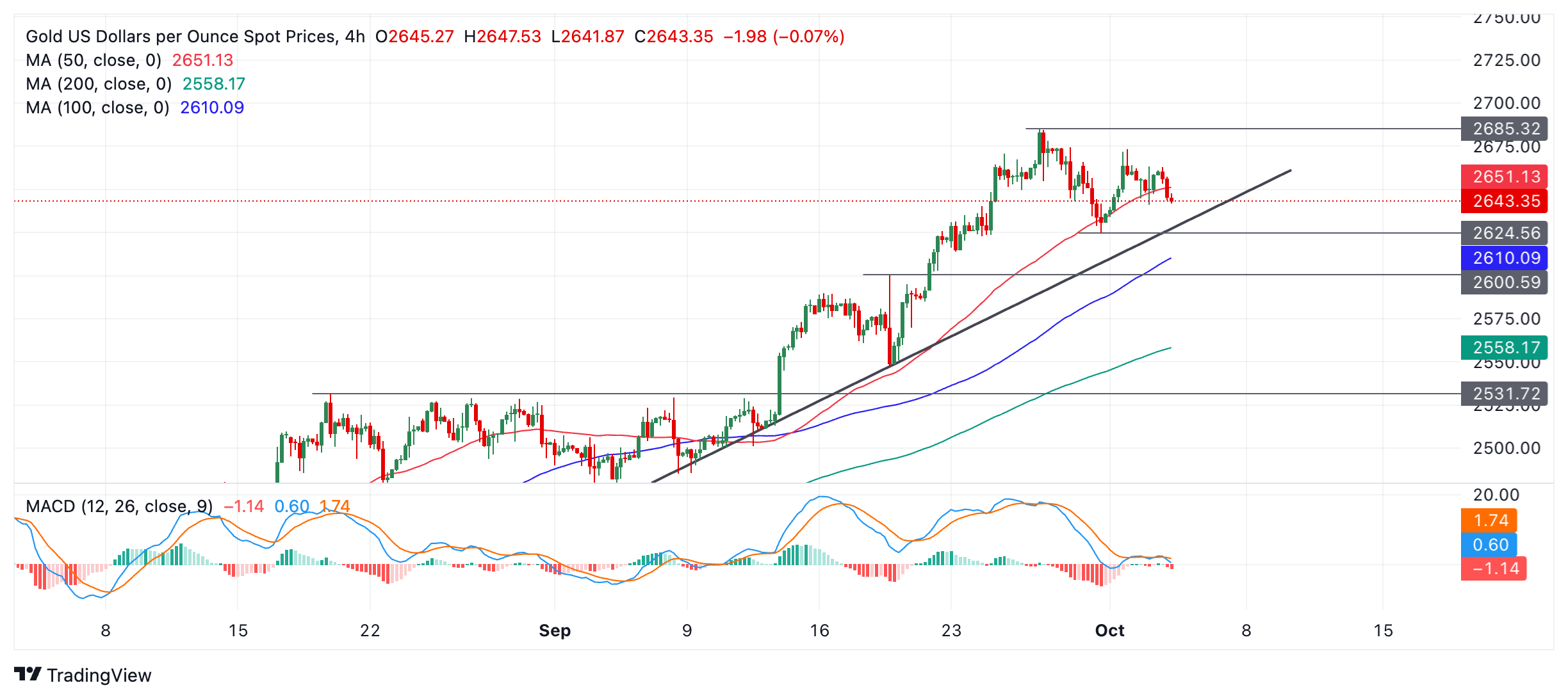Gold trades in a narrow range underpinned by haven demand

- Gold oscillates in a tight range after bets fade that the Fed will continue slashing interest rates aggressively.
- Support for Gold comes from increasing geopolitical risks and lower interest rates globally.
- Technically, XAU/USD begins a leg lower within a tight range.
Gold (XAU/USD) edges lower to trade in the $2,640s per troy ounce on Thursday as it continues its line dance below the record high of $2,685 set last week. Sellers have the edge over buyers as bets fade that the Federal Reserve (Fed) will continue slashing interest rates aggressively in the United States (US), which, in turn, takes the shine off non-interest-bearing assets like Gold.
The downside is limited, however, by support from two key factors: safe-haven flows into Gold due to the fear of an escalation of the conflict in the Middle East and the general trend lower in global interest rates – notwithstanding the Fed’s newfound caution – which enables Gold to still retain its overall attractiveness to investors.
Gold stalls in its ascent as Fed backtracks
Gold continues to see upside capped by seesawing expectations regarding the future course of interest rates in the US. From the chances of the Fed cutting interest rates by another double-dose 50 basis points (0.50%) again in November, standing above 60% last week, these have now fallen to a much less certain level of around mid-30%.
The fall in market bets comes after the release of stronger-than-expected US jobs data, which suggests the US economy is not tilting on a cliff edge. This, in turn, has enabled the Dollar to resurface from its deep dive in August, providing a further headwind to Gold, which is mostly priced and traded in USD. Regarding the health of the US labor market, the release of the most important US employment report, the Nonfarm Payrolls (NFP), will be a critical deciding factor on Friday.
Technical Analysis: Gold enters short-term sideways mode
Gold enters a sideways market mode on the 4-hour chart (below) between the all-time high of $2,685 and a floor at around Monday’s low of $2,625. The short-term trend is unclear and could now possibly be sideways. It would require a breakout either above the top of the range or below the bottom to confirm a new directional bias.
XAU/USD 4-hour Chart
A break above the $2,673 Tuesday’s high would, however, increase the odds of a resumption of the old uptrend, probably leading to a continuation up to the round-number target at $2,700.
Gold is attempting to pierce the red 50-period Simple Moving Average (SMA) on the chart above, however, which suggests building downside pressure.
If a break through the SMA ensues, it will probably take prices down to support from the trendline at $2,630. A break below the $2,625 swing low would likely see prices give way to support at $2,600 (August 20 high, round number).
On a medium and long-term basis, Gold remains in an uptrend and, since it is a foundational principle of technical analysis that “the trend is your friend,” the odds favor resumption higher eventually once the current period of consolidation has ended.
Economic Indicator
Nonfarm Payrolls
The Nonfarm Payrolls release presents the number of new jobs created in the US during the previous month in all non-agricultural businesses; it is released by the US Bureau of Labor Statistics (BLS). The monthly changes in payrolls can be extremely volatile. The number is also subject to strong reviews, which can also trigger volatility in the Forex board. Generally speaking, a high reading is seen as bullish for the US Dollar (USD), while a low reading is seen as bearish, although previous months’ reviews and the Unemployment Rate are as relevant as the headline figure. The market’s reaction, therefore, depends on how the market assesses all the data contained in the BLS report as a whole.
